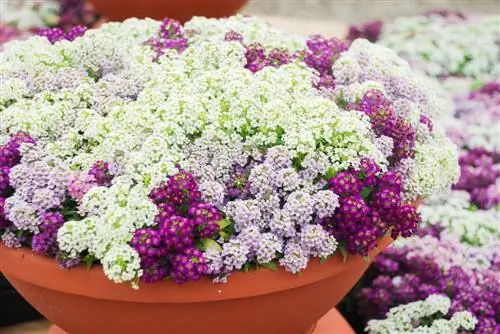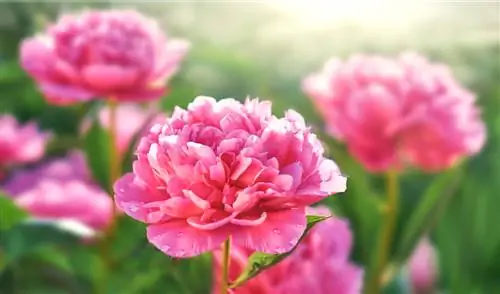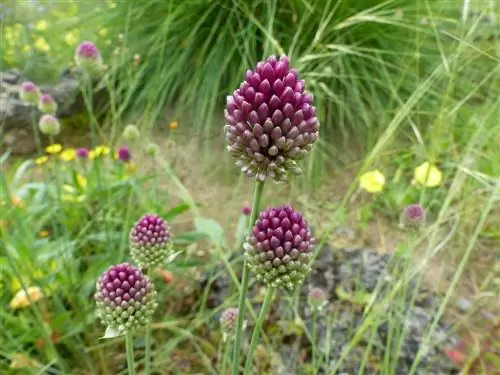- Author admin [email protected].
- Public 2023-12-16 16:46.
- Last modified 2025-01-23 11:22.
Read a commented silverweed profile here with explanations of growth, leaves, inflorescences and flowering time. Tried-and-tested tips explain how to plant and care for Lobularia correctly.

What should you know about silverweed?
Silverweed (Lobularia maritima) is an ornamental, fragrant plant with white, pink, blue, purple or yellow flowers. Popular in rock gardens, balcony boxes or as a ground cover, it prefers sunny locations and calcareous, well-drained soil. Flowering time is from June to October.
Profile
- Scientific name: Lobularia maritima
- Family: Cruciferous vegetables (Brassicaceae)
- Synonyms: beach silverweed, fragrant stonewort, stonewort
- Origin: Mediterranean, Azores, Canary Islands
- Growth type: Perennial
- Growth habit: cushion-forming
- Growth height: 10 cm to 40 cm
- Leaf: lanceolate to obovate
- Flowers: grape-like, lush
- Fruit: pods
- Winter hardiness: not hardy
- Use: rock garden,
Growth
Silverwort is an annual or perennial herbaceous plant with fragrant, white inflorescences. The plant species from the cruciferous family (Brassicaceae) is native to the Mediterranean region. Larger deposits can be seen in the Azores and Canadian islands, mostly on sandy beaches and other coastal locations. In this country, the Mediterranean flower beauty is often planted in rock gardens. By self-seeding, beach silverweed can stay in one location for many years, even north of the Alps, which can be mistakenly interpreted as winter-hardy growth. Read key growth data worth knowing here:
- Growth habit: densely bushy, spreading, cushion-forming.
- Height: 10 cm to 20 cm, rarely up to 40 cm.
- Growth width: 15 cm to 30 cm.
- Stem: ascending, densely hairy.
- Ghorticulturally interesting properties: undemanding, easy to care for, not hardy, tolerates cutting, blooms profusely, smells of honey, ground cover, bee-friendly.
Video: Lobularia maritima 'Snow princess' transforms the balcony and bed into a sea of white flowers
Bloom
The high appreciation of silverweed as a popular ornamental plant is based on these flower characteristics:
- Inflorescence: spherical raceme with numerous individual flowers.
- Single flower: fourfold (sepals 1.5 mm to 2 mm, petals 3 mm to 4 mm long).
- Flowering period: June to October (in mild winter regions until December).
- Flower color: white (varieties also bloom pink, blue, violet, yellow or pastel colors)
- Special feature: aromatic with the scent of honey.
- flower ecology: hermaphrodite
Individual Lobularia flowers are only said to have a moderate nectar content. The exuberant abundance of flowers makes alyssum a much-loved destination for wild bees, honey bees and butterflies.
Leaf
If you want to look at the grey-green stoneweed leaves, you have to hurry up. The foliage of Lobularia maritima cannot be seen among the lush flower clusters. Before and after the flowering period, a silverweed leaf can be recognized by these features:
- Leaf shape: oblong-lanceolate to obovate, entire margins.
- Sheet size: 2.5 cm to 4 cm.
- Leaf color: grey-green
- Arrangement on the stem: alternate
Fruit
Withered, pollinated silverweed flowers produce typical Brassicaceae fruits with these attributes:
- Fruit type: pods
- Fruit shape: stocky-roundish to obovate.
- Fruit size: 2 mm to 3 mm long.
Each pod contains a tiny seed per fruit compartment as a normal and light germinator.
Usage
With its summer carpet of flowers, silverweed is a source of inspiration for imaginative uses. Let these planting ideas inspire you to create picturesque arrangements in the bed and on the balcony:
| Balcony | Plant idea | Beet | Plant idea |
|---|---|---|---|
| Flower box | hanging plant | Groundcover | flowering clematis underplanting |
| Bucket | High-stem underplanting | Bee Pasture | Gap filler in the wildflower perennial bed |
| traffic light | hanging border planting | Cottage Garden | romantic flower strip on the picket fence |
| Stone trough | concealing flower cushion of bare privacy bushes | Natural Garden | bee-friendly mixed hedge underplanting |
| Bowl | fragrant table decorations | Drywall | Flowers on the top of the wall |
| Euro pallet flower box (hanging) | vertical wall greening | Herbal spiral | flowering joint filler on the south side |
Planting silverweed
Three paths lead to the summer silverweed flower festival in the bed and on the balcony. You can buy ready-to-plant silverweed for a price of around 3 euros, wait for the result of self-sowing or grow Lobularia from seeds. These planting tips explain how to do it correctly:
Propagation
Silverwort grown on the windowsill or in the greenhouse starts the season with a vital growth lead. All important conditions for sowing at a glance:
| Silverwort sowing | Key data |
|---|---|
| Time slot | March to April |
| Seed container | shallow bowl |
| Growing substrate | Coconut clay-sand mixture |
| Sowing technology | Press the light germinator firmly, do not cover it |
| germination temperature | 18° to 20° Celsius |
| Germination time | 8 to 14 days |
| Light conditions | bright, no blazing sun |
| Pricking | in groups in small pots |
| Temperatures | 10° to 12° until planting out |
| Beginning of the flowering period | 7 to 9 weeks after sowing |
| propagation care | water sparingly, do not fertilize |
From the end of April you can sow silverweed seeds directly in the bed or balcony box. However, direct sowing postpones the start of the flowering period by several weeks.
Location, soil, substrate
Silverweed develops its optimum at this location:
- Full sun to partial shade.
- On the balcony it is best to be protected from rain and wind.
- Temperature minimum: short-term 5° Celsius, long-term 10° Celsius.
In the garden, scented stonecrop prefers a humus-rich, sandy-gravelly and calcareous soil. Potting soil without peat, enriched with coconut fiber soil as a peat substitute and lava granules or sand for best permeability is suitable as a substrate for boxes, pots and buckets.
Planting Tips
Purchased or pre-grown silverweed is easy to plant. You should be a little concerned with the correct planting. The following planting tips point out details worth knowing:
- The best time to plant is mid-May, after the Ice Saints.
- Silverwort root balls are soaked with water before planting.
- The correct planting distance is 10 cm to 15 cm.
- Plant Lobularia as a hanging plant in containers at the front edge.
- Drainage made of gravel or expanded clay effectively prevents waterlogging in boxes and buckets.
So that silverweed can grow well, thorough watering on the day of planting and afterwards is mandatory.
Excursus
Be aware of the risk of confusion
The trade doesn't take German plant names too seriously. Hobby gardeners know the problem and pay attention to the botanical name when buying silverweed. When you buy Lobularia maritima, you get the annual beauty of the Mediterranean with its lush, seductively scented flower carpets. With Calocephalus brownii you have the annual Australian barbed wire plant, also known as silver wire, in your shopping basket.
caring for silverweed
Silverwort is easy to care for. However, you should not leave the decorative plant completely to its own devices. You can read about what is really important when it comes to proper Lobularia care in these tips & tricks:
Pouring
- Water silverwort when the soil is noticeably dry (finger test).
- Let normal tap water run directly onto the root disc.
- Targeted bombardment with the water hose causes mildew to appear.
Fertilize
- Do not fertilize scented stoneweed in the bed.
- Add liquid flower fertilizer to the water on the balcony every one to two weeks.
Cutting
- Cut off wilted stems promptly to make room for new flower clusters.
- Pruning back by half after the first bloom encourages silverweed to bloom a second time until the first frost.
Diseases and pests
The dense, bushy growth of silverweed arouses the desire of pathogens. Under the influence of warm, dry weather, powdery mildew can occur, visible as a white coating on the gray-green leaves. A rainy summer is just right for downy mildew, recognizable as a grey-brown fungal growth on the undersides of the leaves. As an immediate measure, cut off infected plant parts. An effective home remedy against fungal infections is a mixture of fresh milk and water in a ratio of 1:5.
Silver herbs are a feast for voracious snails. Manual collection, moving barriers made of sharp-edged grit and coffee grounds have proven to be effective control methods. Omnipresent aphids can be effectively combated with a soap and spirit solution, which is also available from specialist retailers.
Popular varieties
These beautiful silver herb varieties are applying for a place in the summer garden and on the balcony:
- Tiny Tim: Standard silverwort classic with white, fragrant flowers from May to October, height 10 cm to 20 cm.
- Rosie O Day: Pink cineraria as an annual hanging plant in the balcony box or flower-rich ground cover in the summer garden, height 10 cm to 20 cm.
- Large Seaweed: Lobularia maritima var. benthamii as the big brother of 'Tiny Tim' with a height of 20 cm to 40 cm.
- King's Carpet: Premium variety from Dürr-Samen with blue-violet flowers and 10 cm height, beautiful as a bed border, ground cover and splash of color in rock gardens.
Steinkraut 'Colorful Cushions': Colorful seed mixture in picturesque pastel tones from salmon pink and apricot to pink, yellow and white.
FAQ
Is silverweed poisonous?
Silverweed (Lobularia maritima) is not poisonous. The plant parts do not contain any ingredients that are harmful to he alth. For this reason, the summer flower beauty is perfect for the family garden with pets.
What flowers can you plant silver herbs together with?
Good planting partners for silverweed (Lobularia maritima) are annual flowers with a similar height and flowering time. Picturesque contrasts are created with blue-flowering Man's Treble (Lobelia) and liver balm 'Blue Cap' (Ageratum). With silverwort 'Snow princess' and dark red nasturtium 'Crimson Emperor' (Tropaeolum majus) you can create a white and red color festival in the hanging basket. In combination with hanging petunias (Petunia hybrida) and hanging geraniums (Pelargonium peltatum), silver herbs appear as flowering cascades.
Is silverweed perennial and hardy?
In the Mediterranean region, silverweed thrives as a perennial. In protected locations on the Azores or the Canary Islands, scented stonewort can bloom profusely all year round. In the Mediterranean climate, seaweed has not learned to survive in frost. North of the Alps, silverweeds die off after the first night frost. Nevertheless, in this country the impression of multi-year growth often arises, because by self-sowing, silverweed can survive in the location for many years.






